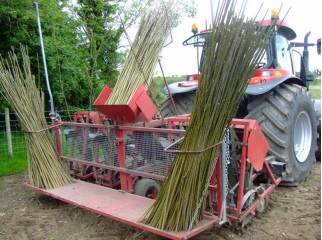Some 2,500 people flocked to Tuesday’s Energy In Agriculture event in Gurteen College, Co. Tipperary.
Farmers travelled from all corners of the country to hear of the potential advantages that growing renewable crops and the implementation of other renewable technologies may offer their businesses.
There was also a keen interest among farmers on the Renewable Heat Incentive (RHI), which is expected to be brought before the cabinet for approval in the coming weeks.
Fiona Thorne, a Teagasc Research Officer at the Rural Economy & Development Centre in Ashtown, Co. Dublin, gave a detailed breakdown of the profitability figures associated with growing willow.
Thorne said: “We all know that these energy crops are not just an annual crop; they’re something that you plant today and have on your farm for the next two decades.
“We need to look at the cashflow over that time period and bring it back to a net present value (NPV). We can then compare these multi-annual crops with the annual crops that farmers are used to growing.”
Thorne continued to say that producers can’t just look at a bio-energy crop in isolation.
You need to look at the economics of the bio-energy crop in the context of conventional agricultural systems or other land uses.
Assumptions
When we talk about a bio-energy crop, she said, we don’t have the equivalent of the Teagasc National Farm Survey to generate profitability data.
And, as a willow crop is grown over a 22-year period, the profitability figure of the crop must be brought back to a net present value (NPV) to allow for comparisons to be carried out with other farming systems.
To establish a comparative profitability value, Thorne used a number of assumptions. These included:
- A 22-year time period;
- 10 harvest cycles after the establishment period;
- 7t of Dry Matter per hectare in the first harvest year and 10t of Dry Matter per hectare every year after that (based on a two-year harvest cycle);
- Figures were generated with and without an establishment grant (a €1,040/ha establishment grant was available up to 2015 and it was payable at a rate of 75% in the first year and 25% in the second year);
- The owner of the willow doesn’t have to cover the cost of harvesting the crop (the purchaser foots this bill);
- Moisture content of 55% and a price of €25/t fresh weight.
Costs
When the grant for establishment is not factored into the equation, she said, it will take 10 years before the crop breaks even.
The farmer is looking at negative cashflow up to year 10 when there’s no establishment grant. This generates a NPV of €2,950/ha over the 22-year time horizon.
“If you plant the willow crop and have it there for 22 years, based on the assumptions, it’s the equivalent of the farmer getting €220/ha each year.”
If an establishment grant was reintroduced, she said: “The willow crop reaches break even point in year seven.”
The grower, she said, would expect to get an annual stream of €310/ha; that’s based on a price of €25/t fresh weight and an establishment grant of €1,040/ha.
How does it compare to spring barley?
When compared to the average returns generated by spring barley and winter wheat producers in recent years, Thorne said: “For the average winter wheat producer, that achieved average levels of efficiency in 2016, they would be better off continuing to grow winter wheat crop and not converting to willow.
“We see a different story for the average spring barley producer who hasn’t achieved good returns over the last three or four years.
“Yields haven’t been great for spring barley in particular and prices have been dismal to say the least. And, even in the absence of an establishment grant for willow, the average spring barley producer would see benefits if they convert to willow.”
Without the establishment grant, the gross margins generated from willow would be €70/ha more than that of spring barley; that increases to €200/ha for willow crops grown with the aid of an establishment grant.
A word of warning
Despite the potential to produce higher gross margins, Thorne stressed that the supply chain needs to be in place and there needs to be an end use for the product before farmers consider making the switch.

